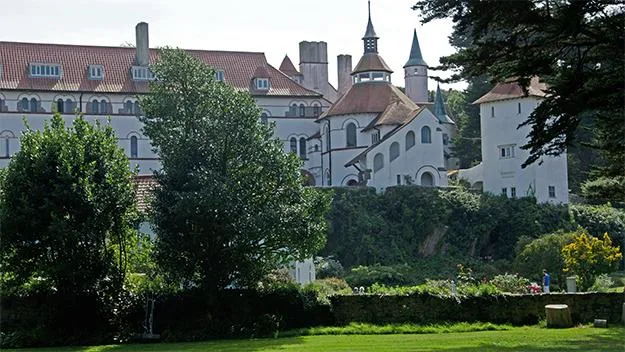The grizzled Welsh fisherman with mischievous eyes and a sing-song voice sounded a little melodramatic when he said, “The royal family, and I mean Her Majesty The Queen, Charles, William and baby George owe their inheritance to the tides of Tenby.”
When I roared with laughter, he looked surprised. “Look, Boyo,” he said, from his lobster pot seat on the quay of Tenby harbour. “When Henry Tudor was being hunted down by soldiers in 1471, he took refuge here, hid in a tunnel that led to the harbour, and when the king tide came in, he fled to France in one of the mayor’s boats. No high tide, no escape, certain death and no Queen Elizabeth the First or Second … for that matter.”
He had a point. Tenby’s harbour empties at low tide just like a bath when you pull the plug, leaving boats sitting at precarious angles on the sand. Henry Tudor did, in fact, narrowly escape death that day in 1471, returning to Wales 14 years later with a victorious army which won him the throne as Henry VII. Henry VII is Elizabeth II’s (15) great uncle. And if Henry hadn’t escaped that day, who knows who would be on the throne today. A bit of Welsh logic, I suppose.
However, I hadn’t come to Tenby for a history lesson, but to walk from its medieval harbour to the estuary at Laugharne, where the celebrated Welsh poet, Dylan Thomas, spent his later years writing verse on that “heron priested shore”, to put it in the poet’s own words.
2014 is the Centenary of Dylan Thomas’ Birth and to mark the event, the Welsh have opened a 16km stretch of footpath that allows hikers to walk between the iconic little port and the charming hamlet. It may be only a short section of the Wales Coast Path which, in its entirety, offers 1400km of uninterrupted hiking around some of Britain’s most beautiful cliffs and beaches, but it stitches together the Pembrokeshire section of pathways with that of its neighbouring county, Carmarthenshire, both voted two of most spectacular stretches of coastline in Europe. Along the entire length of the Wales Coast Path are many inspiring sights, including the four World Heritage castles of Caernarfon, Beaumaris, Conwy and Harlech, where Prince Charles was invested as Prince of Wales in 1969. Then there’s the Italianate fantasy village of Portmeirion; the seemingly endless sandy beaches of the Atlantic coast, where surfers flock from all over Europe; and the country’s smallest city, St Davids, with just 1408 souls who fit snugly into its 12th century cathedral.
In comparison, the walk between Tenby and Laugharne is a modest stroll, about 16km in all, but before setting off, I took the ferry from Tenby to Caldey Island, home to a monastery since 1084. At low tide, the ferry goes from Castle Beach, 50 metres around the headland in front of the ice-cream cabin that sits on the sand beneath the town’s pastel-coloured terraces that line the cliffs.

The ice-cream cabin and the view of South Beach, Tenby.
The colours of Tenby’s houses are more reminiscent of Portofino, on Italy’s Ligurian Coast, than Wales. So it didn’t come as a surprise when the Cistercian monastery on Caldey Island looked like a turreted castle on the Rhine. Further up the hill towards the lighthouse are the ruins of the original religious community, next to a 6th century cross. The little church of St Illtyd’s looks as if it could have been built in days of King Arthur and Merlin. From a certain angle you can see its moss-covered spire lists like the Leaning Tower of Pisa and to be frank I wouldn’t care to live in the Old Priory next door.

St Illtyd’s Church, Caldey Island, and the Caldey Island ferry.
A colleague once wrote that “the joy of walking a coastal path is the simplicity of its navigation. Keep the sea on your left or keep the sea on your right, and walk.” And the path from Tenby to Laugharne is easy to navigate. It begins with a delightful wooded stretch to Saundersfoot, where three tunnels, once used to transport coal, save the calves the effort of climbing up several steep hills.
Next comes a gentler landscape of undulating fields, neatly divided by hedgerows, that rises above sandstone cliffs. Here, the path heads inland onto the high ground of Gilman Point that overlooks the 11-kilometre expanse of Pendine Sands: pearl grey under cloud; sparkling white, yellow and blue under sun.
Once used for numerous land-speed record attempts between 1924 and 1927, the sands are now deserted and offer step after step of solitude, with only the sound of breaking waves as your constant companion.
On the approach to Laugharne, through bluebell woods with lazy estuary below, the path wends its way past discreet but sturdy stands inscribed with Dylan Thomas’ poetry, “high tide and the heron dived when I took the road”.

The castle at Laugharne, South Wales.
My walk’s end was next to the castle. Yes, it seems there are ancient castles around every other corner in Wales. And further along on a slight rise is one of Dylan Thomas’ former homes, The Boat House. Here, you can savour the estuary view while enjoying tea and traditional Welsh cakes.

The Boat House, Dylan Thomas’ home, on the River Taf estuary, Laugharne.
Up the hill is Browns Hotel, the poet’s local pub that dates back to the 1750s and offers bed & breakfast. Here you can sample the local brew, Brains ale, at Thomas’ favourite table in the corner, where there’s a photograph of the bard and his wife, Caitlin.
Browns Hotel, Laugharne, with a portrait of the poet on the sign. Dylan Thomas’ first home in Laugharne, Seaview ([email protected]), on Market Lane, is now a comfortable Bed & Breakfast, where you can book a night in the poet’s old bedroom.
Dylan Thomas’ first home in Laugharne, Seaview ([email protected]), on Market Lane, is now a comfortable Bed & Breakfast, where you can book a night in the poet’s old bedroom.
Not everyone is a Dylan Thomas fan, but you have to tip your hat to his choice of home. The beaches in Wales are as awe-inspiring as they are in New South Wales and one wonders whether our founding fathers were influenced by this when they named the new colony.
What the two places don’t have in common is the same weather. As Dylan Thomas’ line “the pale rain over the dwindling harbour” suggests, Wales has its fair share of wet weather. And yet my experience was two weeks of glorious blue skies. And if the sun does shine, with 1400 kilometres of the Wales Coast Path to explore, you’ll find adventure at every turn.



